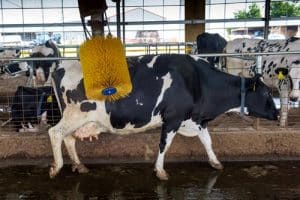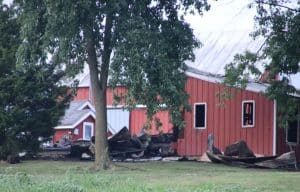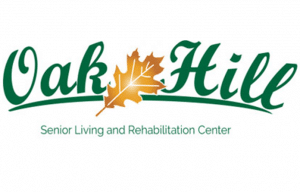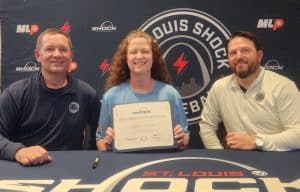The future is now at Reinhardt dairy farm

It’s not a “cow washer,” but this rotating brush springs into action when a cow rubs against it, helping scratch a back or ear – whatever the cow desires. (Alan Dooley photo)
Farming has traditionally been a labor-intensive, sun-up to sun-down – and then some – occupation. It has been plagued by heat, cold, rain and snow. And much of it has been repetitive – even sometimes boring, plain hard work. It has attracted some next generations of offspring and driven others to the city.
So when a group of Monroe County teachers participating in a “STEM on the Farm” workshop visited the dairy farm of David and Josh Reinhardt on Thursday, they got the opportunity to see just how much science, technology, engineering and mathematics are benefitting the agriculture industry at this fully automated, 280-head Holstein dairy farm.
Farming is still hard work, with long hours, but leveraging technology is creating productivity and extraordinary quality at the father-son Reinhardt dairy farm northeast of Red Bud.
David and Josh Reinhardt are working on smoothing the operations at their computer-operated dairy farm that swung into operation in March following nearly a year of construction and preparation.
The farm is home to almost exclusively Holstein cows who live, eat, sleep and move about at their own paces in a huge, computer-monitored and controlled building. There, they are milked when ready, on their own schedules, by four computer-controlled mechanical milking machines without repeated human intervention. The results flow automatically into a 3,000-gallon stainless steel holding tank and chilled to 38 degrees.
Clearly, the days of bending to sit on a single-legged milking stool, washing a cow’s teats, and then milking her into a pail — or even hooking up a milking machine — all by hand, are over at the Reinhardt farm.
The farm is an integrated facility consisting of a 90-by-390-foot building that houses a room full of air compressors and pumps, four milking machines, and a central computer system that monitors and commands all operations. The computer even directs a high pressure flow of ankle-deep water to wash the floors five times a day. The waste is recycled in a collection area outdoors, eventually producing fertilizer and clean water.
Even the sand cows sleep on is cleaned and recycled.
“We’d rather clean and reuse sand than buy it by the truckload,” Josh said.
For those concerned about the cows’ welfare, it should be noted these animals are very vocal when irritated, uncomfortable or simply uneasy. They moo and even bellow under those circumstances. The entire facility, even during the added “stress” of 25 visiting teachers, was absolutely silent — except for the humming and swishing of various machines, including huge fans circulating the air and keeping the thermometer 10 to 15 degrees below outside temperatures.
The building’s dimensions take into account optimal air circulation for the cows’ comfort. In the winter, canvas panels are closed and the cows’ body heat remains inside.
Each cow has a numbered identification tag on one ear. On the other ear is a nickel-sized metal disk that identifies each individual animal to the computer system. It opens gates as they move about.
For example, when they choose to move to the milking area to relieve the discomfort of full udders, it allows them to pass through a gate. And it will prevent them from “changing their mind” and leaving before being milked.
When the cows walk into one of the four automated milking machines, the computer tag and computer system “talk with each other” to identify the individual cow. A previous laser scan of each cow’s udder and teats – updated by another scan – guides the machine as it washes and sanitizes them.
Then the milking machine is applied and milking begins.
The results, and the record of each event – hundreds of times each day – are gathered and stored in the computer where they can be displayed in a variety of formats for analysis and management decision making.
The computer even alerts the Reinhardts at night if any issues arise.
“Sometimes I can correct the issue by my smart phone,” Josh said. “Otherwise, it’s more like the old days and I am getting up and coming down at 2 a.m.”
A crucial result? The cows are collectively delivering nearly 3,000 gallons of milk per day. And, equally important, it is absolutely top quality.
The Reinhardts are part of the Prairie Farms cooperative system, and their high quality earns an added
$1 per hundredweight, or hundred pounds of milk, which is 11.63 gallons.
The Republic-Times stayed behind after the group of teachers departed to learn more about the Reinhardts and their ultra-modern farm.
David and Josh, and Josh’s new bride Emily are the second and third generation of Reinhardts, respectively.
David’s parents married in 1947 and bought the first increment of today’s 1,000 acres in 1954.
“They bought 100 acres, built a small house, a milking parlor and started with about 20 head of cattle,” he remembered. “They used to tell us their wedding presents included 12 chickens and two mules,” he added, laughing.
“Before we took this step,” David added, “we milked 100 cows each day, usually twice, and it took a minimum of 12 hours, each day, every day.”
The diet fed to animals today includes a blend of several products grown on the farm, including haylage, ground corn, other edibles and specific minerals and supplements. No antibiotics are employed in the herd and none are in the milk that is picked up daily.
“I think they eat a better diet than I do,” David said.
The Reinhardts don’t have any plans for significant changes to their operation.
“This is it for now,” David said.
They are monitoring data, analyzing results, making adjustments to maximize milk production and adjusting to “future farming,” making it today’s farming.






